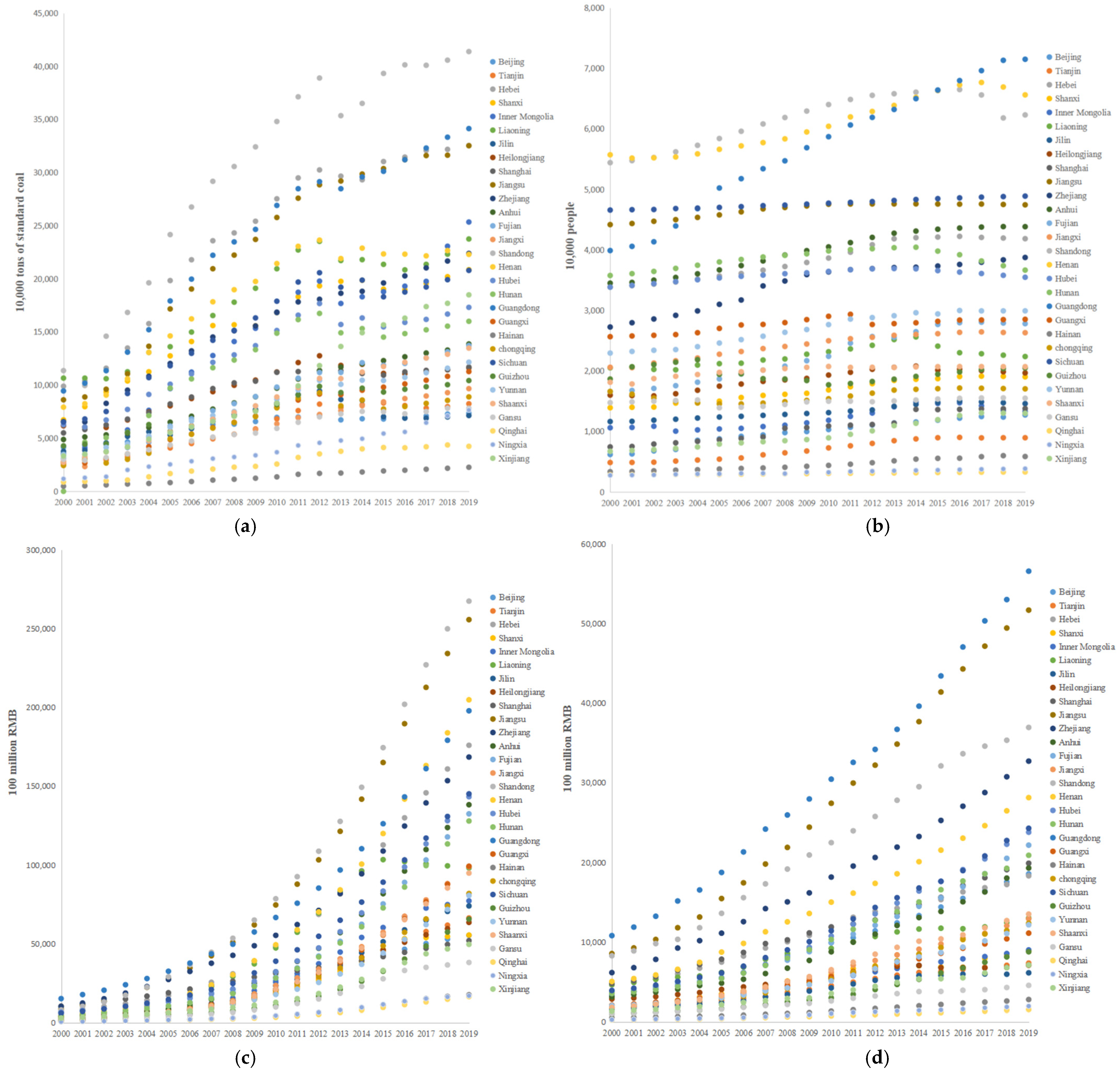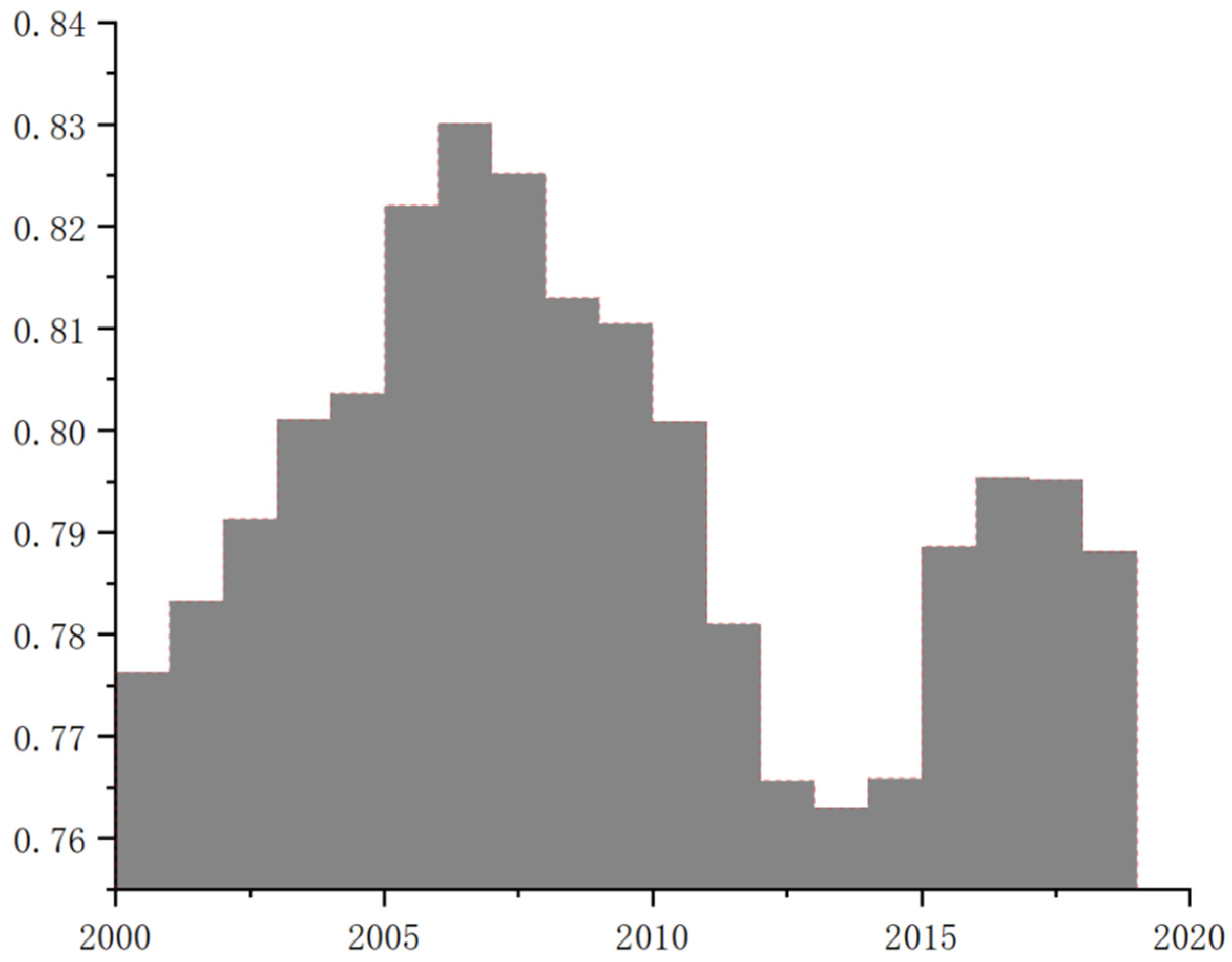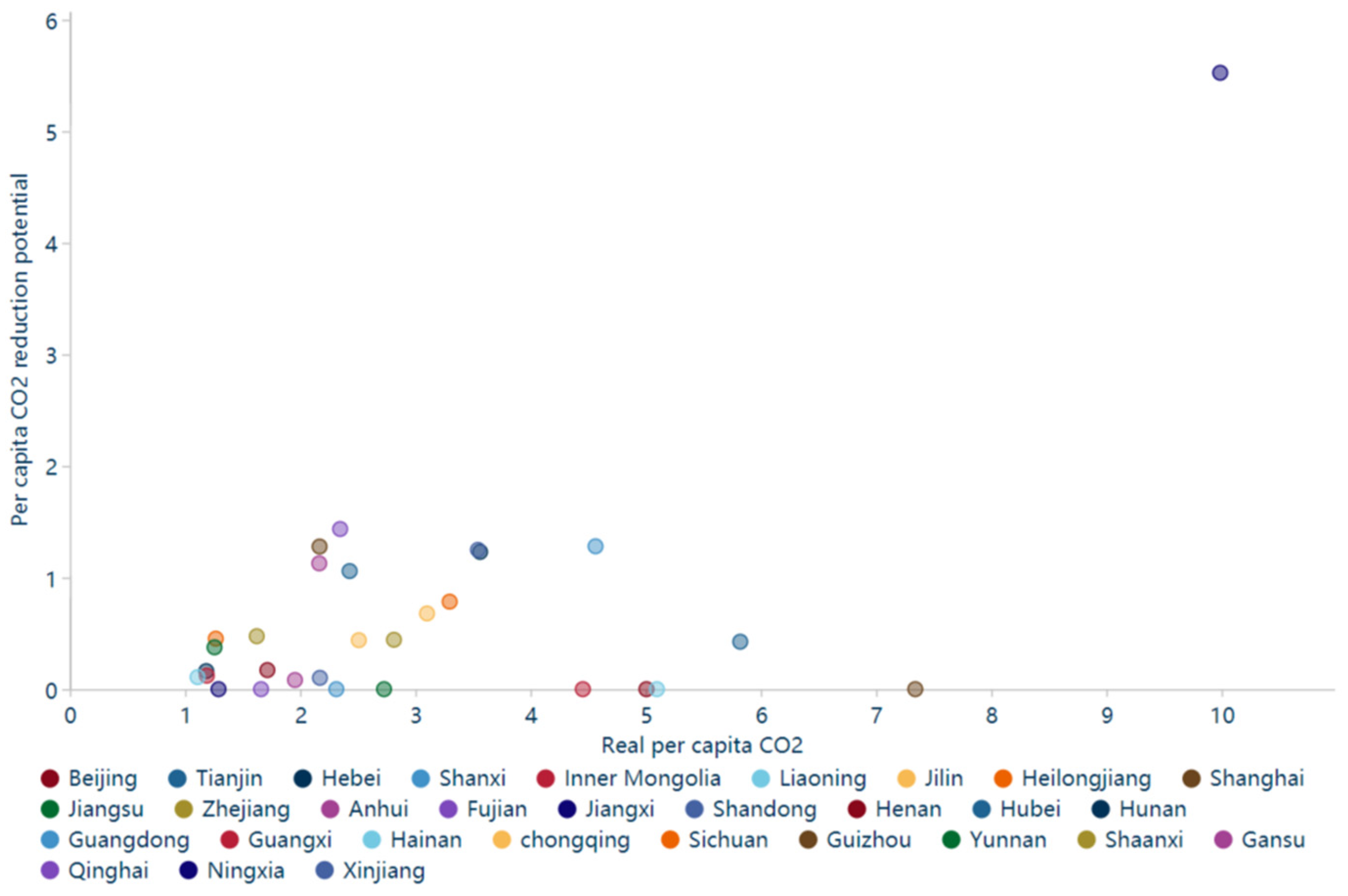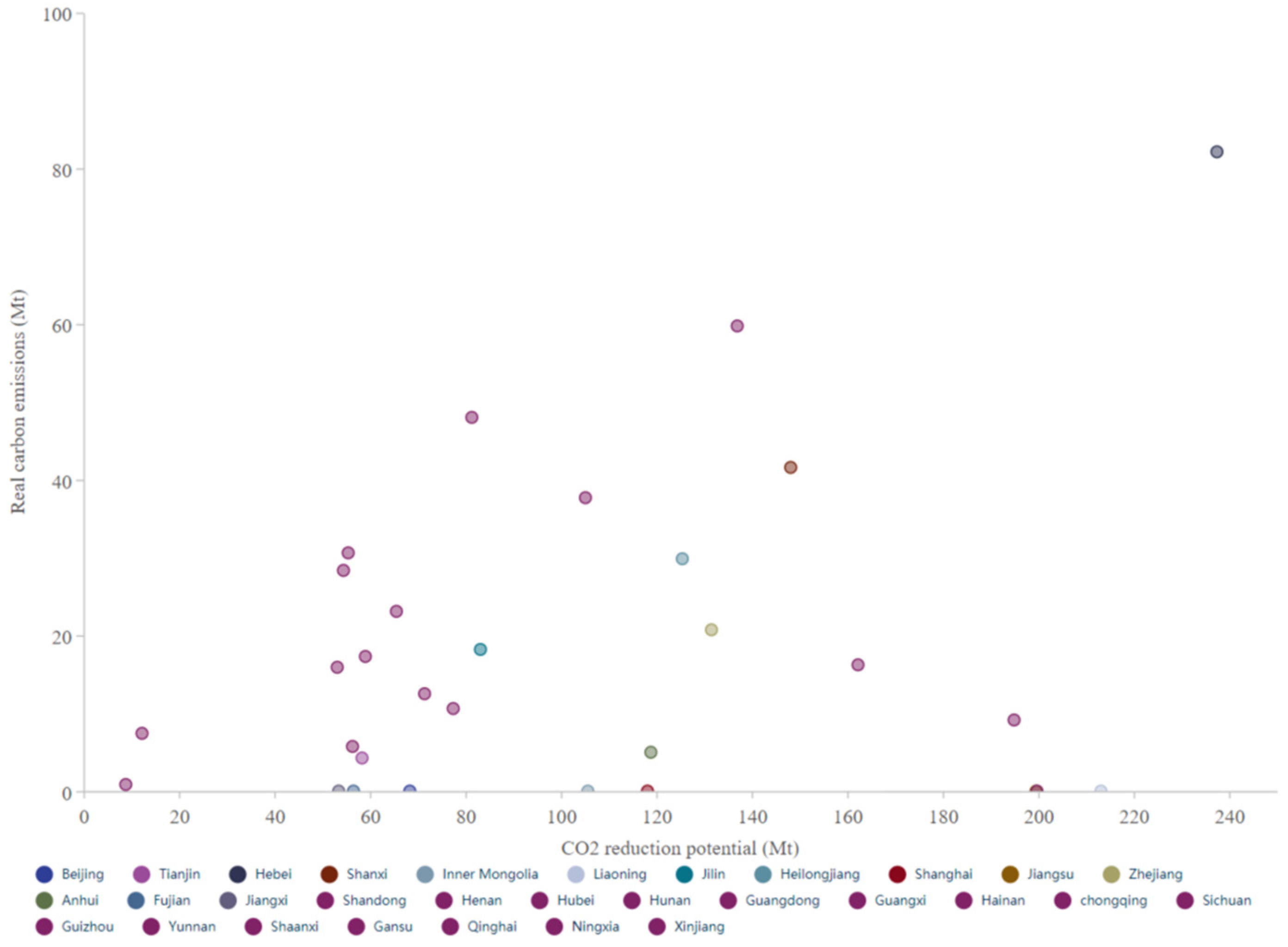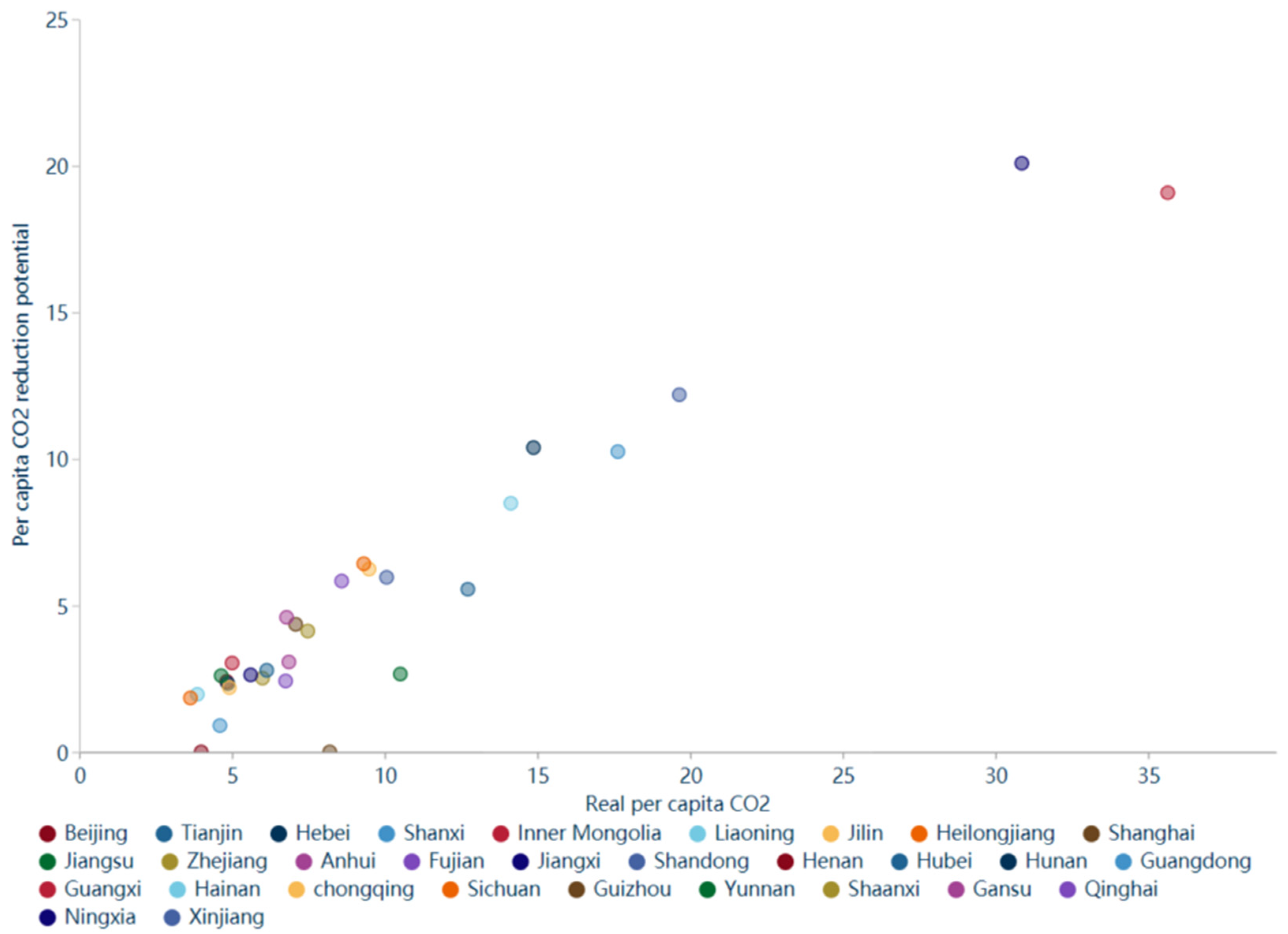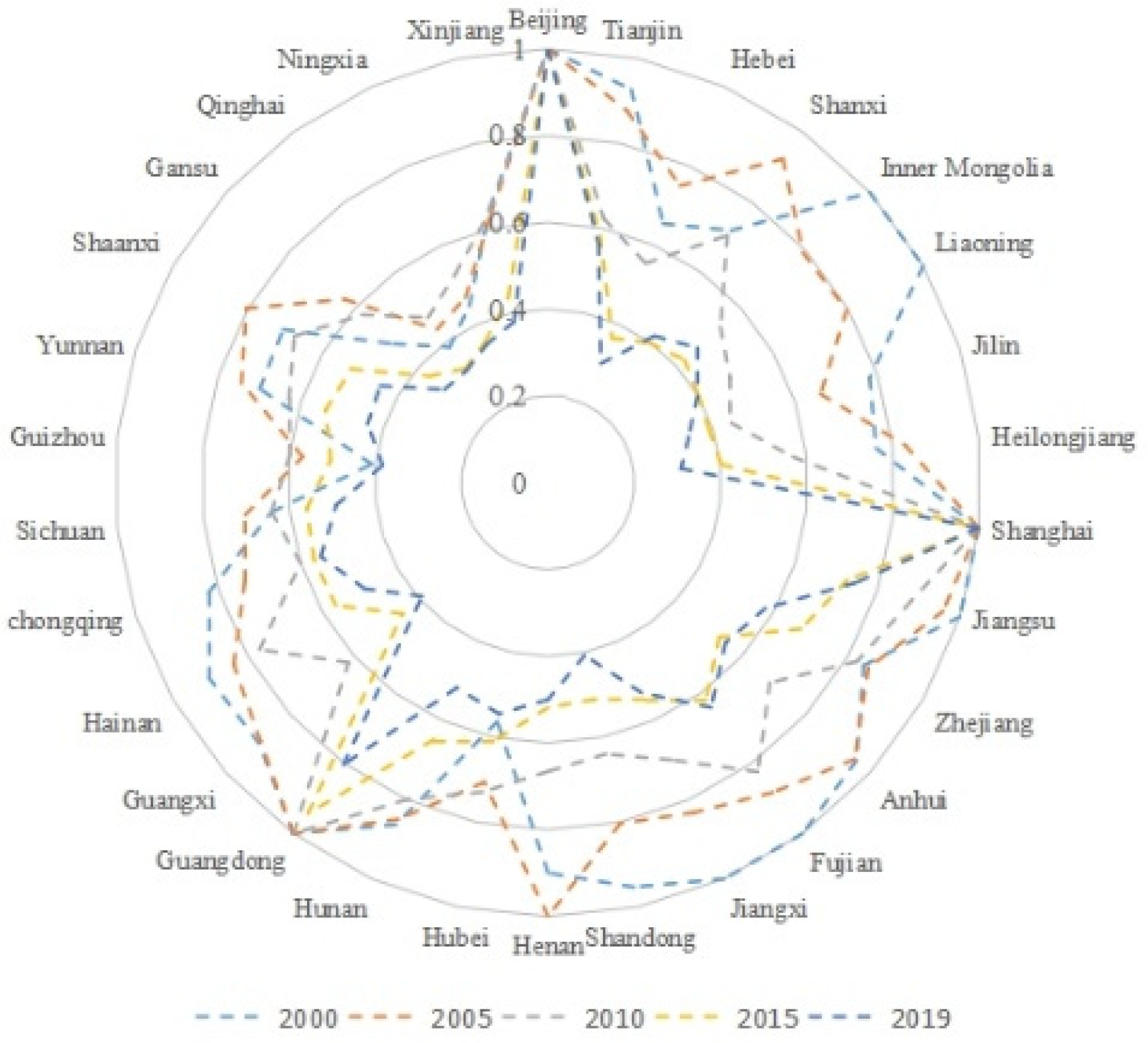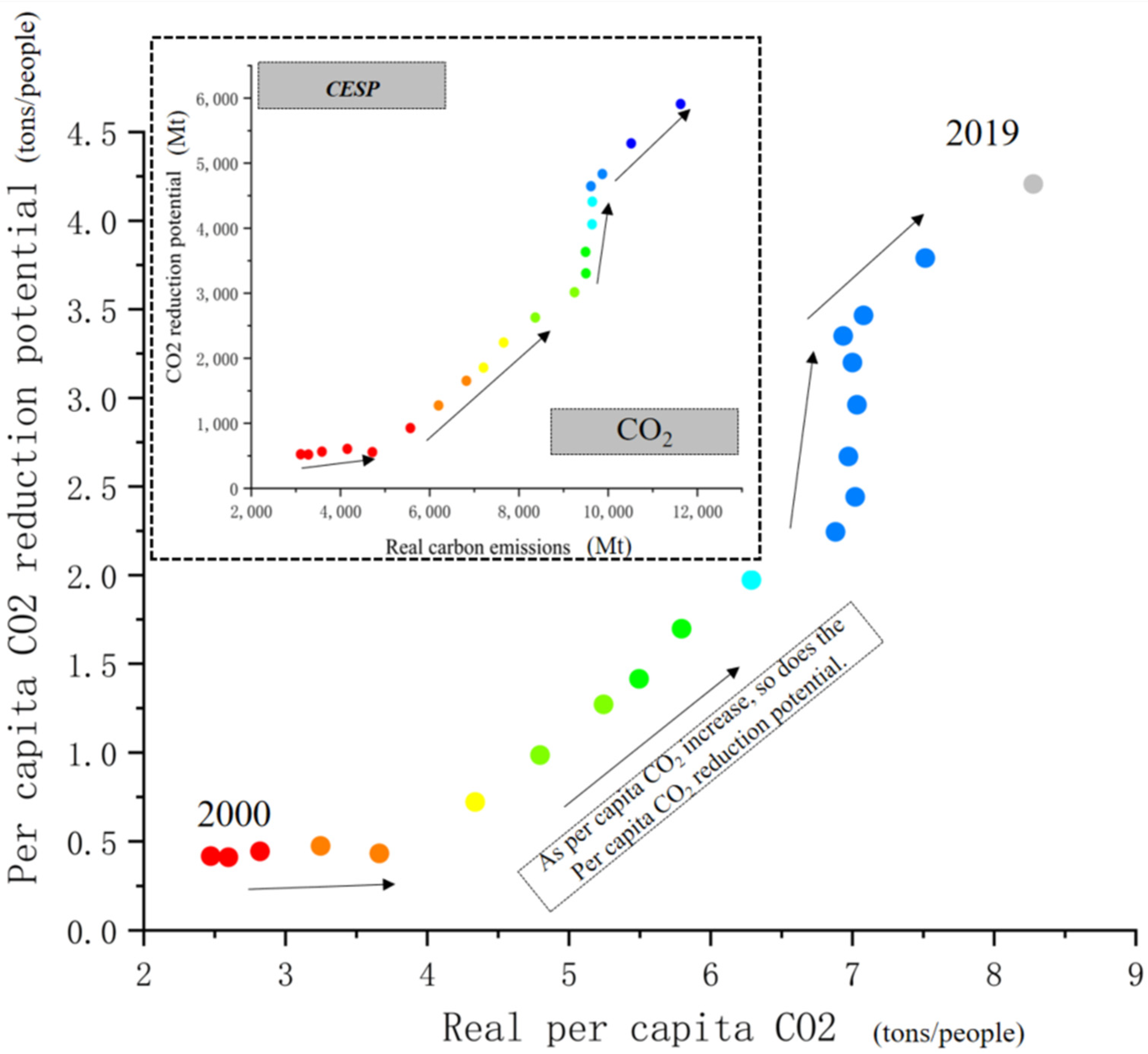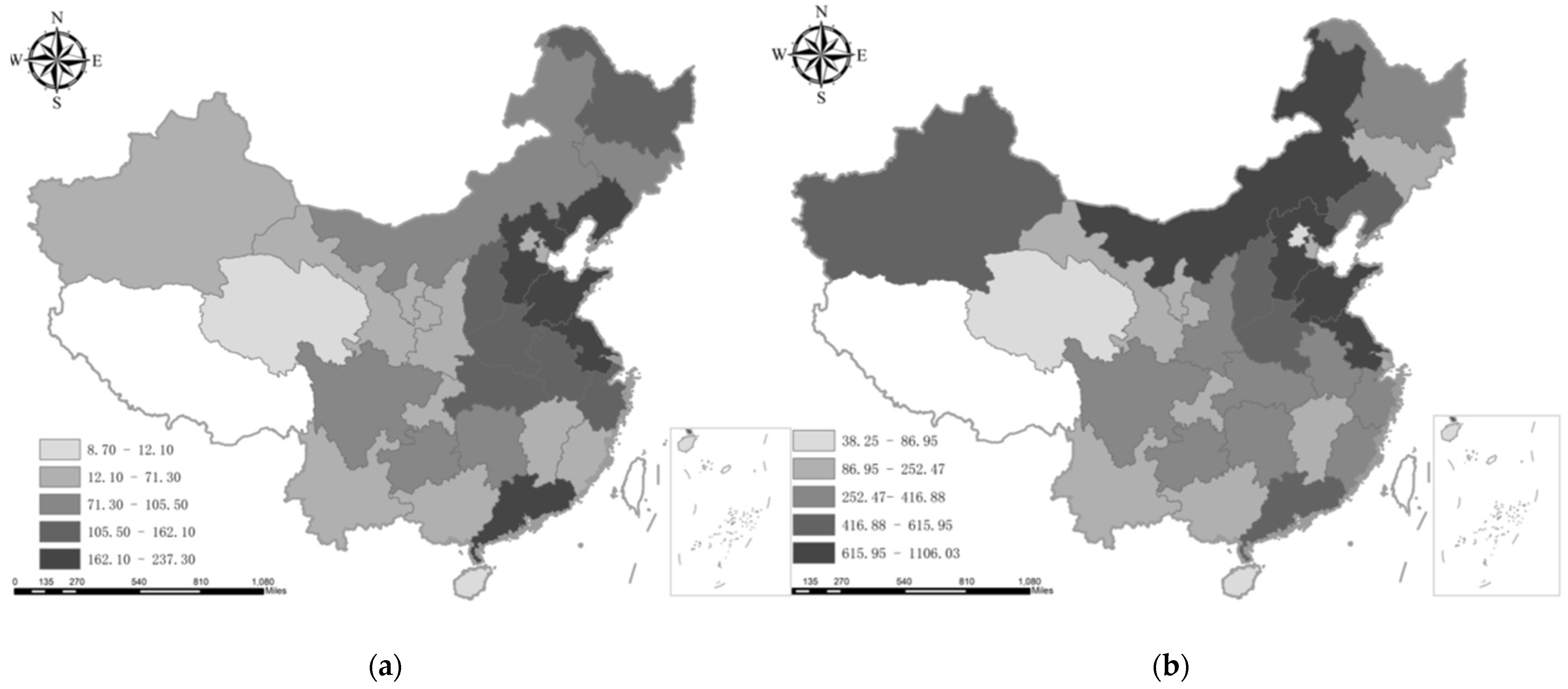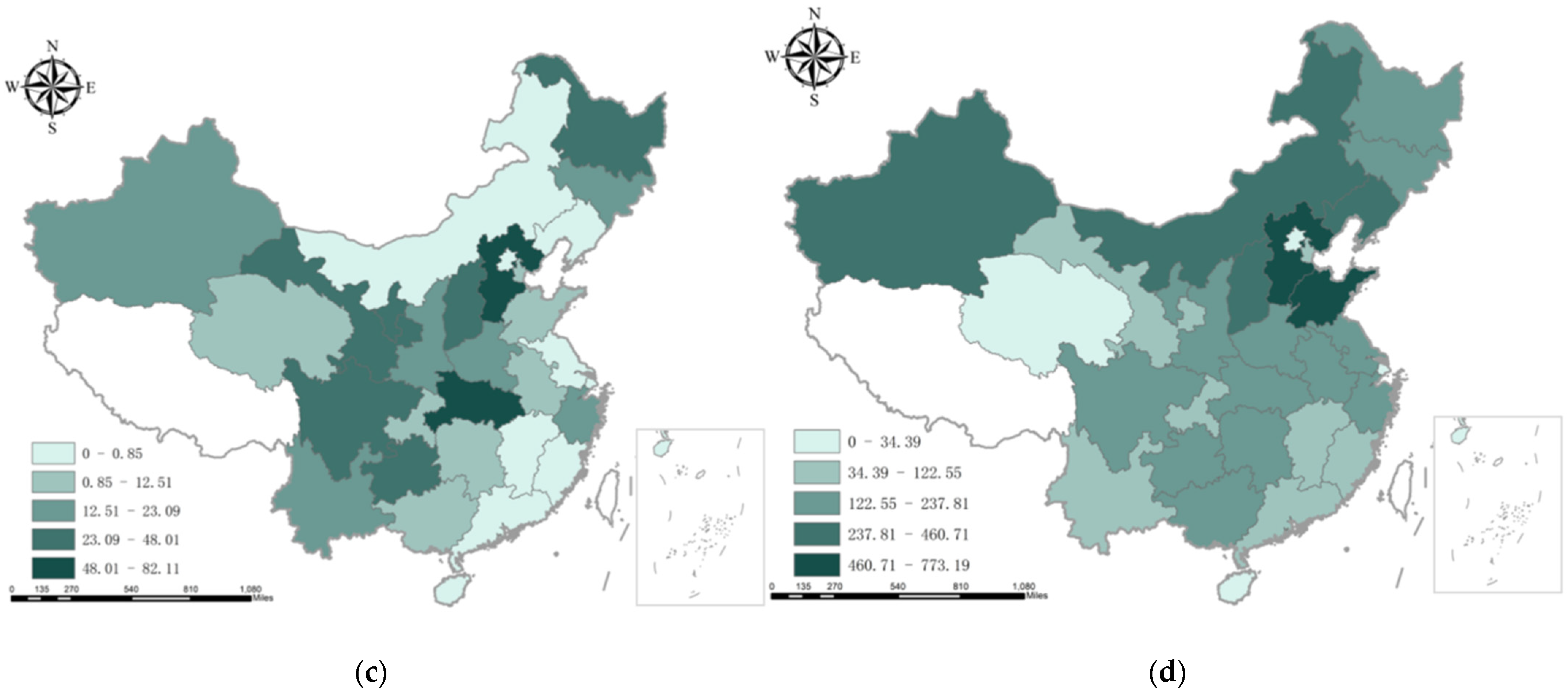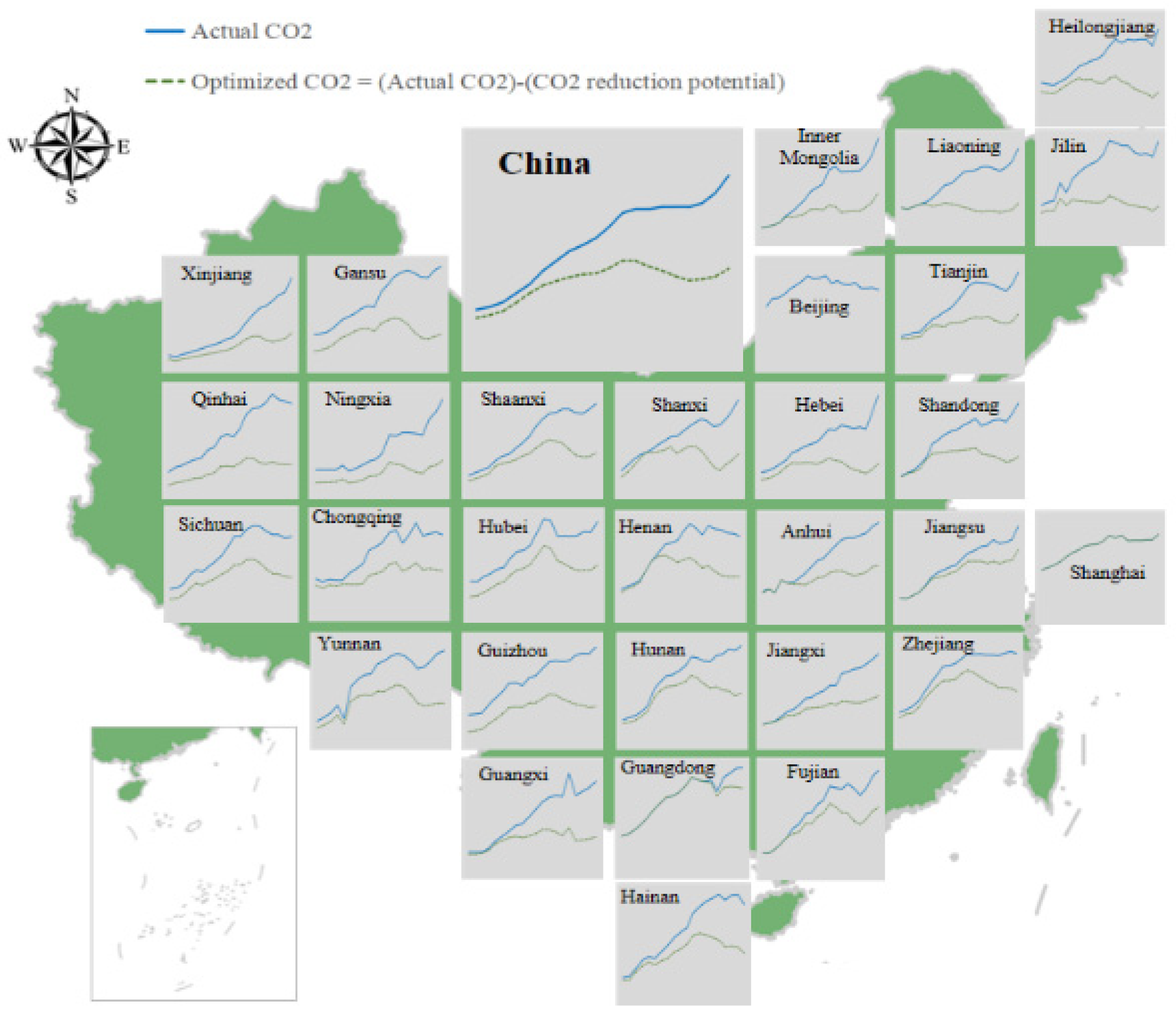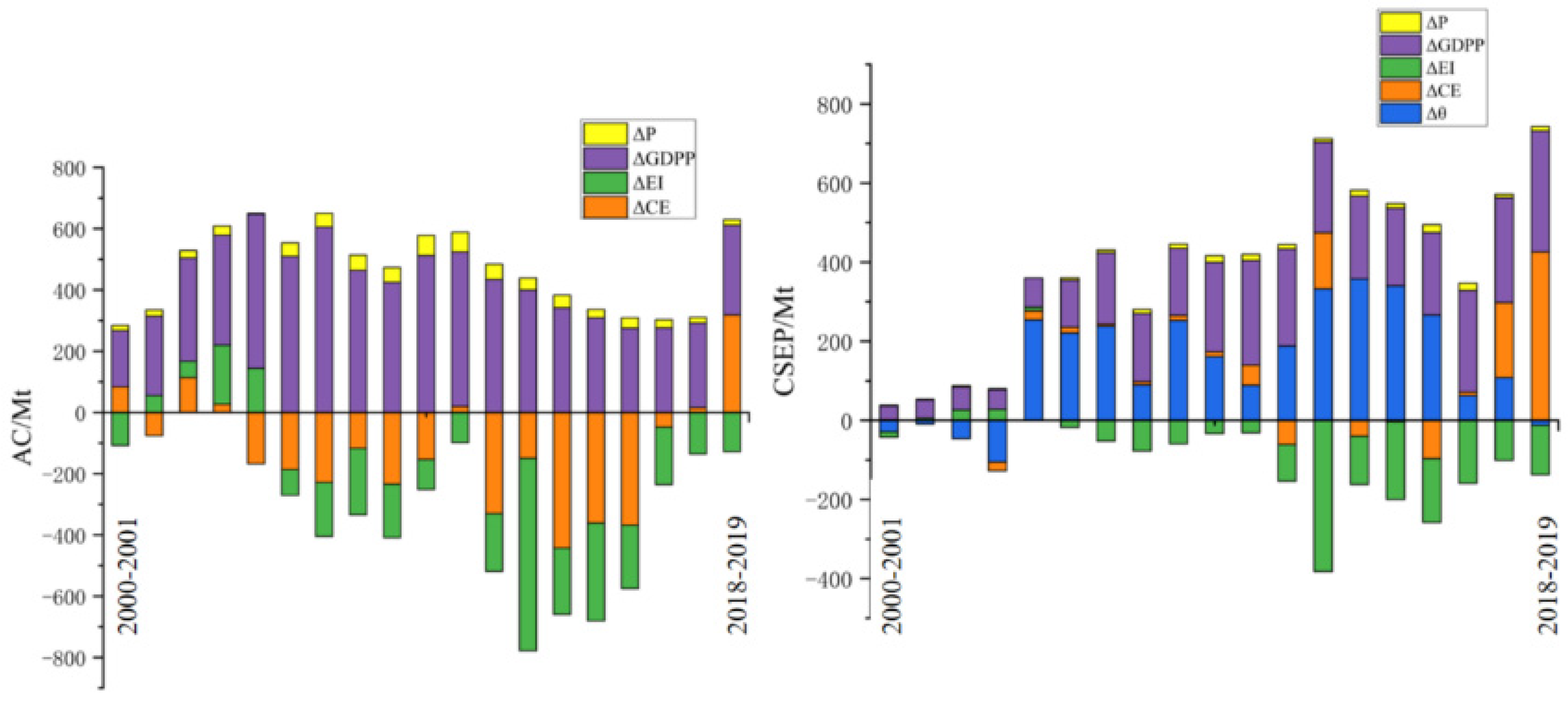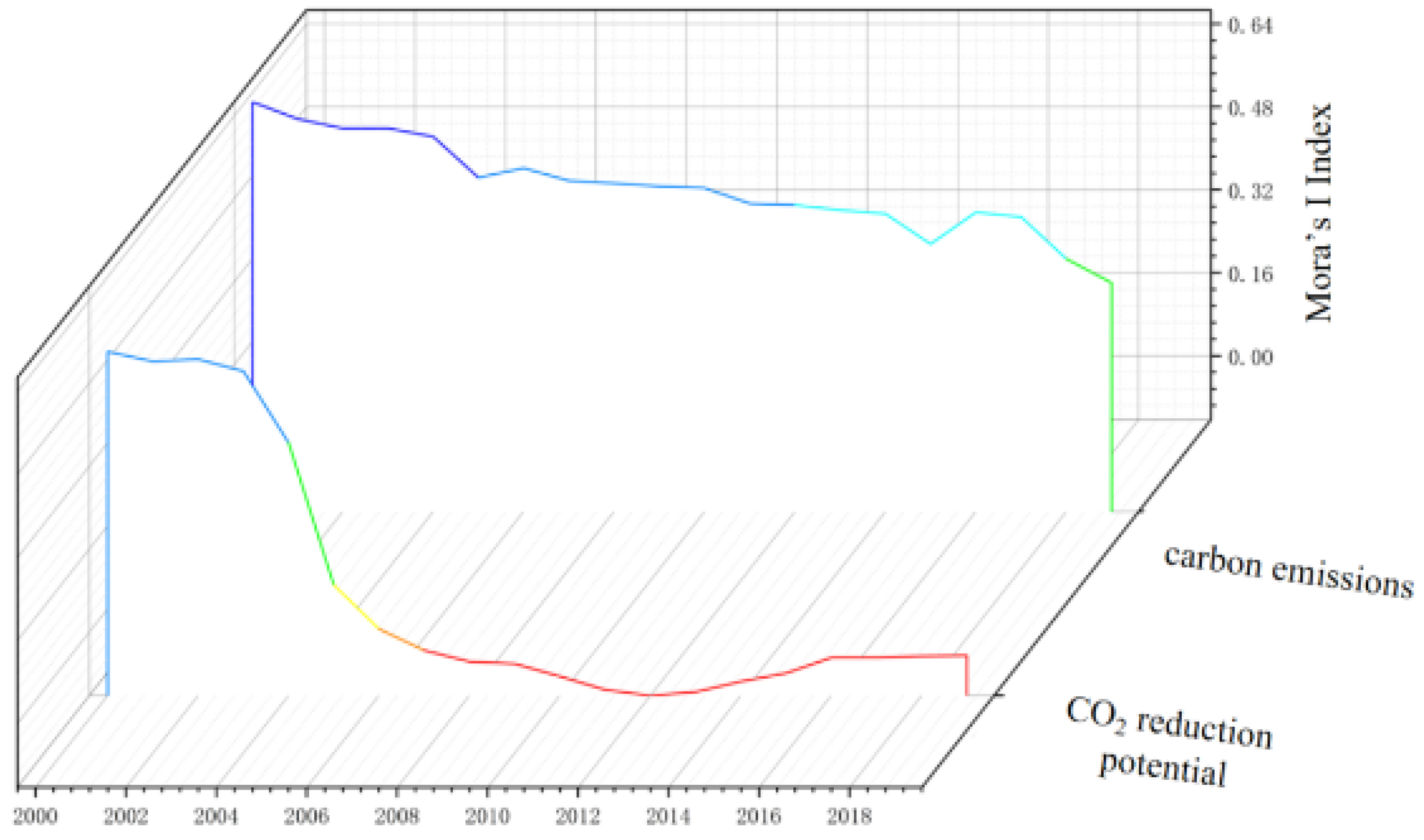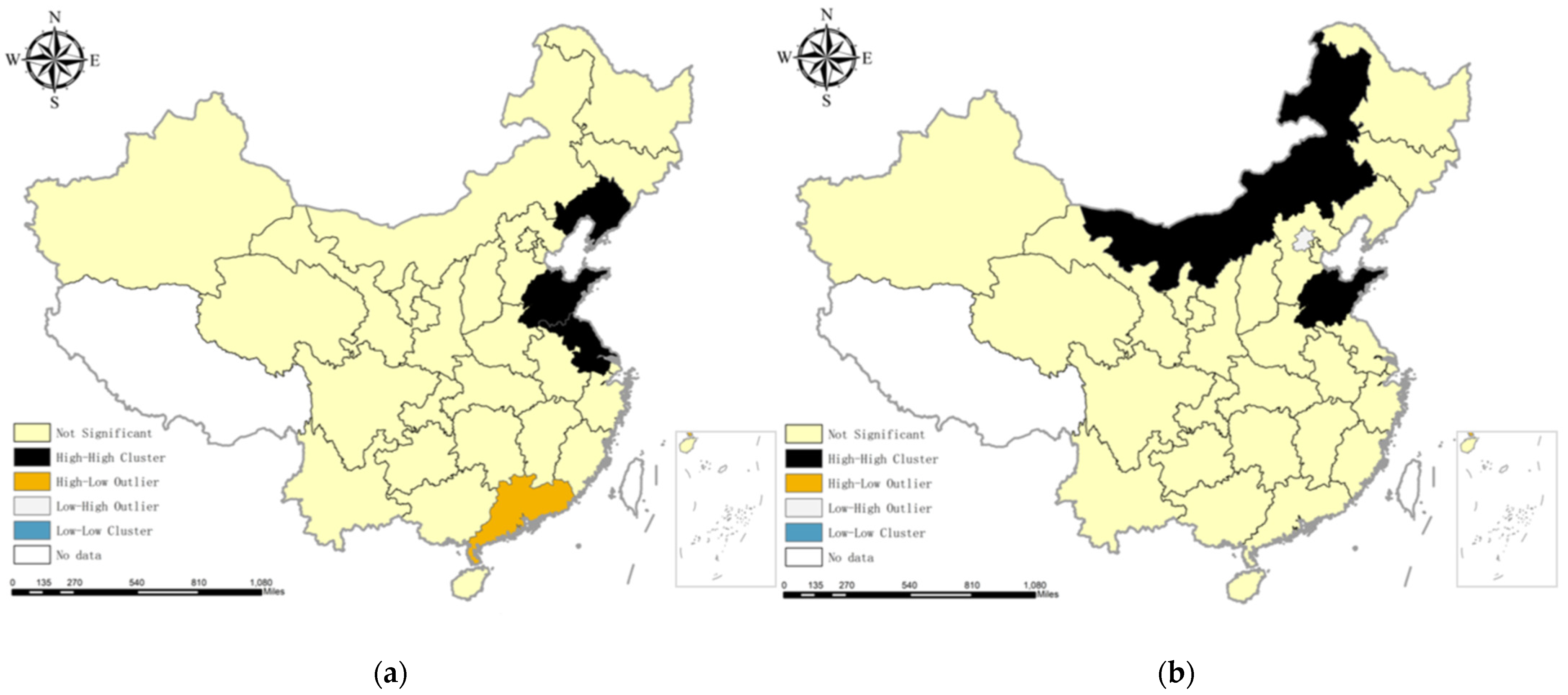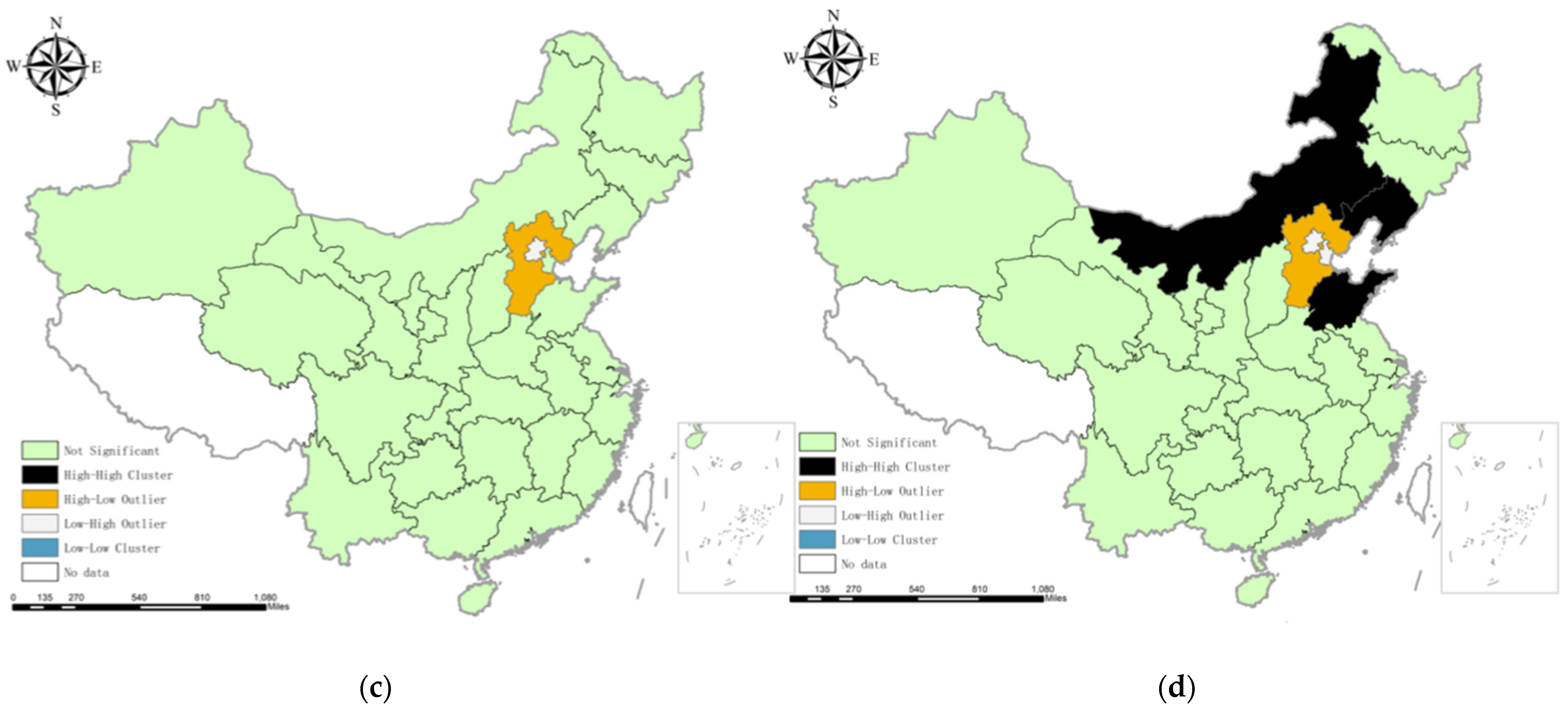1. Introduction
Currently, sustainable development has gradually become a global issue, which requires that the advancement of the society should not be at the expense of the environment [
1]. Since the late 1980s, mitigating global warming has become an important issue for mankind [
2]. Extreme weather events, failure of measures to control climate change, major natural disasters, biodiversity loss, and ecosystem degradation are most likely to have severe impacts. In recent years, rapid economic growth has paid serious resource and environmental costs [
3]. Then, climate change affects economic growth by affecting productivity and labor force. Therefore, reducing CO
2 and air pollutants is the primary goal of energy and environmental policy in the world.
After the reform of the economy, China has developed rapidly; meanwhile, it has brought serious environmental problems. According to the statistics of CO
2, China became the world’s largest carbon emitter in 2007 [
4], accounting for 21% of global CO
2 [
5]. Then, China has actively undertaken the responsibility of emission reduction and pledged to strive to achieve carbon peak by 2030 and carbon neutrality by 2060. To achieve the “dual carbon” goal, the related planning calls for accelerating green and low-carbon development and reducing carbon intensity. Therefore, facing the great pressure of environmental protection, China should identify the key factors and obstacles and formulate targeted policy recommendations.
Decomposition analysis has been widely applied by scholars in the analysis factors of energy, CO
2, pollutants, etc. Index decomposition analysis (IDA), structural decomposition analysis (SDA), and production-theoretical decomposition analysis (PDA) are the three main categories in decomposition analysis. In 1991, IDA was employed in energy analysis and environmental analysis [
6]. Torvanger [
7] employed IDA to decompose carbon emissions into six impact primers. After that, IDA has been widely employed in the study of influencing factors at the national level and industry level [
8,
9,
10,
11,
12]. The SDA method, from the economic system, explores the factors affecting carbon emissions based on the input–output table [
13,
14,
15], but it has strict requirements on data and needs to be analyzed by input–output tables. PDA method explores influencing factors through combination decomposition method and data envelopment analysis (DEA) method [
16,
17,
18]. PDA, proposed by Zhou and Ang [
19], is applied to study more potential influencing factors of CO
2 in OECD. Compared with the latter two methods, IDA has many advantages. First, from the energy system, IDA is easily able to study drivers at the macro level, which can help policy makers formulate targeted policies [
20]. Second, it can easily analyze and compare the differences of carbon emissions in different regions without high requirements for data [
21,
22].
Low efficiency and resource misallocation will lead to excessive carbon emissions, while the carbon reduction potential (
CESP) is the carbon emission generated for such reasons.
CESP can be reduced by improving resource utilization efficiency and optimizing resource allocation. DEA is applied in many aspects, including energy and environmental evaluation [
23,
24,
25,
26]. Total factor energy efficiency (TFEE), calculated by DEA, is used to study energy efficiency in the study [
27]. They concluded some areas of inefficiency in China. Scholars also employ DEA to investigate energy saving and CO
2 reduction potential [
28,
29,
30,
31,
32,
33]. The above IDA approach can investigate single-factor efficiency. While it quantifies the impact of “absolute” efficiency using factors such as energy intensity, it cannot assess “relative” efficiency. DEA can evaluate “relative” efficiency to complement this shortcoming. The advantage of it is that we could investigate the potential in energy and carbon emissions by improving efficiency; however, the effect of absolute efficiency could not be identified sufficiently. Then, the ZA method, proposed by Zhou and Ang [
19], combines DEA and decomposition analysis. The method is an extension of DEA, but efficiency in the form of ratio does not perfectly reflect changes in relative efficiency over time. Thus, PDA could not investigate the efficiency change. Takayabu et al. [
30] combined the IDA and DEA models to overcome some of the above defects, and studied the impact of three different efficiencies. This paper also employs it to study the factors of CO
2 and
CESP.
Here, we first investigate the differences between CESP and carbon emissions in each region. Then a DEA–IDA analysis framework was used to explore the factors of CO2 and CESP. Finally, the heterogeneity, in time and space, of factors of CESP and CO2 is studied by a spatial econometric model, geographically and temporally weighted regress (GTWR). The contributions of this paper are as follows: (1) we analyze the importance of CESP in the realization of dual carbon goals, and compare the differences between CESP and CO2. (2) The DEA–IDA framework was used to explore five factors affecting carbon emissions and CESP. (3) In this paper, GTWR was employed to investigate the spatio-temporal heterogeneity of factors of CESP and CO2 in 30 provinces, providing a reference for the formation of specific policy implications.
This study is organized as follows.
Section 2 provides methodology. We describe data in
Section 3.
Section 4 presents and discusses the results. Finally, we conclude this study.
3. Results and Discussion
3.1. Analysis of CESP
As shown in
Figure 1, Beijing, Shanghai, and Guangdong have higher efficiency, while the western region is generally less efficient, with serious resource misallocation and excessive waste. The efficiency of Hebei is decreasing, which may be due to the acceptance of a large amount of outdated production capacity, resulting in low production efficiency. Meanwhile, the westward relocation of high-emission industries has also led to low efficiency in the west, among which Qinghai is the lowest. This shows that the transfer of industries cannot solve the problem of resource misallocation and excessive waste. The rectification of these backward production capacities and the development of high-tech industry are important ways to optimize resource allocation.
As carbon emissions increase, so does
CESP. The growth of
CESP can be divided into four stages: 2000–2004 (the first stage), 2005–2010 (the second stage), 2011–2016 (the third stage), and 2017–2019 (the fourth stage). From 2000 to 2004, as carbon emissions increased,
CESP remained at a stable level. From 2005 to 2010, with the increase of carbon emissions,
CESP also increased. From 2011 to 2016, the growth rate of
CESP far exceeded the CO
2, which may be due to the misallocation of resources, resulting in low production efficiency. The fourth stage is similar to the second stage. As shown in
Figure 2,
Figure 3,
Figure A3 and
Figure A4, in 2000,
CESP of eight provinces were zero, but in 2019, only two provinces had zero
CESP, and
CESP of most regions is greater than the value in 2000, which shows that with the development of the economy, the misallocation of resources is gradually increasing, resulting in excessive waste of energy.
In 2000, there was no obvious relationship between CESP and CO2, and the distribution was relatively scattered. Hebei, Shanxi, Heilongjiang, and other regions had more carbon emissions; meanwhile, CESP was also greater. However, Shandong, Liaoning, Guangdong, and other regions have high carbon emissions, but have little CESP. However, in 2019, the correlation between carbon emissions and CESP is more obvious than in 2000, among which Hebei has the largest CESP. Each province shows that with the increase in carbon emission, CESP increases. Its model R square is 0.81, and the coefficient is 0.56, which means that when carbon emission is 1 unit, the carbon emission reduction potential increases by 0.56 units. Provinces with more carbon emissions have correspondingly larger emission-reduction potentials.
There is a strong relationship between per capita CO2 and per capita CESP. This remarkable relationship is also divided into four stages: 2000–2004 (the first stage), 2005–2010 (the second stage), 2011–2016 (the third stage), and 2017–2019 (the fourth stage). In 2000, Hainan has the smallest per capita CESP and per capita CO2, and Ningxia is the region with the largest per capita CESP and per capita CO2. There was also no obvious relationship between per capita CESP and per capita CO2, and the distribution was relatively scattered. In 2019, the per capita CESP and per capita CO2 were lower in Beijing, and the per capita CESP and per capita CO2 in Ningxia and Inner Mongolia are the largest. The correlation between per capita CO2 and per capita CESP is also more obvious than in 2000. Each province shows that with the increase in per capita CO2, the per capita CESP increases. Its model R square is 0.92, and the coefficient is 0.62, which means that when per capita CO2 is 1 unit, the per capita CESP increases by 0.56 units.
CESP is increasing, which shows that resources have not been used effectively, and there is a phenomenon of resource misallocation and waste. It can be seen from
Figure 4 that the
CESP of Beijing, Shanghai, and Guangdong is almost zero, which means that these regions have high resource-utilization efficiency and low emission-reduction pressure. If the
CESP of the three northeastern provinces is zero, they can achieve carbon peaking before 2030, but the actual situation is that they have not reached the peak, which shows that optimizing resource allocation and improving resource utilization efficiency are of great significance for the three northeastern provinces to reach the peak. Xinjiang, Gansu, Hebei, Shanxi, Inner Mongolia, and other regions have undertaken high-energy and high-emission enterprises and output electricity roles, resulting in low resource-utilization efficiency in these regions and high
CESP. There are also problems of low resource-utilization efficiency in other regions. If the resource-utilization efficiency is improved and
CESP is reduced, it will promote the realization of carbon peaking and carbon neutrality as soon as possible. Hainan’s optimized carbon emissions show signs of peaking. The peak time is three years earlier than the actual situation, and the peak value is 37% lower than the actual value. The optimized carbon emissions in Zhejiang showed signs of peaking in 2013, but their actual carbon emissions have not yet peaked. The optimized peak is 26% lower than the carbon emissions in 2019. Qinghai, Sichuan, Hunan, and Guizhou can all reach their peaks earlier after the resource utilization efficiency is improved. Among them, Qinghai has the most obvious difference, and peak value is 65% lower than the actual observable peak.
3.2. Results of the Decomposition
Carbon emissions are split into two parts,
AC and
CESP, in this paper. As shown in
Figure 5, in
AC, per capita GDP and population are positive contributing factors. The former is the main contributing factor, which indicates that the increase in GDP is accompanied by a large CO
2 emission, and we are not currently decoupling the economy from CO
2. However, the contribution of per capita GDP is declining, indicating that economic growth is moving toward a low-carbon direction. Energy intensity and carbon emission coefficient are negative contributing factors, and the improvement of energy utilization efficiency and energy structure restrains the increase in CO
2. In
CESP, similar to
AC, per capita GDP and population are still positive contributing factors. Energy intensity is the main negative contributing factor, and the contribution of the carbon-emission coefficient is more to increase
CESP. Unlike
AC, the change in efficiency increases
CESP, indicating that resource misallocation, waste, and low utilization efficiency have increased
CESP, which even exceeded per capita GDP in 2012–2016. Therefore, optimizing resource allocation and improving resource-utilization efficiency is of great significance to reduce
CESP. It can be seen from the discussion in the previous section that
CESP accounts for a large proportion of carbon emissions and improving resource utilization efficiency is of great significance for carbon peaking and carbon neutralization.
3.3. Spatial Correlation Analysis
The spatial correlation analysis of CO
2 and
CESP from 2000 to 2019 was carried out, employing Arcgis 10.2. According to
Figure 6, CO
2 shows a strong positive correlation, and
CESP also shows a coexistence of positive and negative correlations.
As shown in
Figure 7, clustered graphs of carbon emissions and
CESP are presented. In 2000, Liaoning and Shandong form high-high agglomerations, surrounded by regions with high carbon emissions. Guangdong constitutes high–low agglomerations, surrounded by regions with low carbon emissions. Hebei is a high–low agglomeration, surrounded by regions with low
CESP. Beijing is a low–high agglomeration, surrounded by regions with high
CESP. In 2019, Inner Mongolia and Shandong form high–high agglomerations, surrounded by regions with high CO
2. Beijing is low–high agglomerations, surrounded by regions with high emissions. Inner Mongolia, Liaoning, and Shandong form high–high agglomerations, while Beijing and Tianjin form low–high agglomerations.
3.4. Results of GTWR
The residuals of the GTWR regression results are applied to investigate the spatial autocorrelation test. According to
Table A4, the spatial autocorrelations were randomly distributed, indicating that the effect was good and the reliability was high in GTWR. As shown in
Table A5, the results of GTWR are significantly better than the results of OLS regression.
3.4.1. Impact of Efficiency on CO2 and CESP
According to
Table 2 and
Table 3, production efficiency can reduce both CO
2 and
CESP. It is the best way to decrease CO
2 and
CESP. This shows that improving resource utilization efficiency and optimizing misallocated resources are the key measures for China to achieve the dual carbon goal. The improvement of efficiency includes the optimization of resources and the advancement of technology. The optimization of resources reduces
CESP. In 2019, the coefficients in Beijing, Tianjin, Hebei, Inner Mongolia, and other regions are relatively large. Hebei is −8.08, which means that the efficiency of Hebei increases by 1%, and
CESP decreases by 8.08%, 62.47 Mt of
CESP. The improvement of efficiency reduces carbon emissions, among which Guangdong, Guangxi, Qinghai, and other regions are the most obvious. The improvement of efficiency in some regions leads to more carbon emissions, such as in Ningxia, Shaanxi, Heilongjiang, and other regions. The impact coefficient of Shaanxi on CO
2 is 0.34, which means that the efficiency of Shaanxi increases by 1% and then CO
2 increases by 0.34%, subsequently. The degree of regulation in these regions is also weaker than that in the eastern region. Most production still employs traditional technologies in the western area. The initial profitable technology of enterprises is dirty technology, so the research and development of new technologies is not clean technology, thereby increasing CO
2 [
46]. Therefore, improving the research and development of clean technologies and rectifying high-emission industries is one of the top priorities in these regions.
3.4.2. Impact of Energy Mix on CO2 and CESP
From
Table 2 and
Table 3, it can be seen that the deterioration of the energy mix (increase in coal consumption) in each region has a positive impact on CO
2 and
CESP, and greater
CESP hinders China from achieving the dual carbon goal. The impact of the coal proportion in each province on carbon emissions has decreased. This is because the state has made significant contributions to develop clean energy and reduce coal consumption, resulting in the marginal impact of coal proportion gradually decreasing. In 2019, the proportion of coal has a greater impact on CO
2 in the western region. Xinjiang is 0.63, which means that the proportion of coal in Xinjiang is reduced by 1%, and carbon emissions are reduced by 0.63%. Xinjiang has received high-emitting industries from the eastern region, resulting in an increase in local CO
2. Meanwhile, due to the increase in the power transmission from Xinjiang to the east, carbon emissions from other regions have also been transferred to Xinjiang. In 2019, in Shandong, located in the eastern region, the proportion of coal has a positive impact on
CESP, and the coefficient is the largest, 3.17, which means that the coal proportion is reduced by 1%, and
CESP is reduced by 3.17%. Shandong is an economically developed province, but its development model is accompanied by high energy consumption and high CO
2. With the development of industrialization and urbanization, secondary industry is developing rapidly, which creates more demand for energy. Meanwhile, coal accounts for a large proportion in Shandong [
47]. On the whole, differences are obvious in the impact of coal proportion on CO
2 and
CESP. The regions with greater impact on CO
2 are concentrated in the west and some eastern regions dominated by fossil energy, and the regions with a greater impact on
CESP are concentrated in the central and eastern regions. Therefore, all regions should appropriately control coal consumption.
3.4.3. Impact of Energy Intensity on CO2 and CESP
According to
Table 2 and
Table 3, it can be seen that the increase of utilization efficiency in energy will reduce carbon emissions and
CESP. In 2019, energy intensity had a greater impact on CO
2 in Inner Mongolia, Shanxi, and Hebei, with Inner Mongolia being the largest, meaning that Inner Mongolia’s energy intensity decreased by 1% and carbon emissions decreased by 1.17%. The
CESP of Jiangsu, Zhejiang, Inner Mongolia, and other regions is greatly affected by energy intensity, of which Jiangsu is 3.84. However, the reduction of energy intensity in Shandong, Henan, Guangdong, and other regions will increase
CESP, of which Guangdong is −9.2%. Meanwhile, Xu [
48] believes that high efficiency in energy may trigger rebound effects and increase energy consumption and lead to excessive energy input, resulting in diminishing returns to scale, misallocation, and congestion of resources, and finally increase
CESP.
3.4.4. Impact of Per Capita GDP and Urbanization Rate on CO2 and CESP
According to
Table 2 and
Table 3, the impact of per capita GDP on CO
2 is positive, which indicates that rapid economic growth will be accompanied by an increase in CO
2. The coefficients, except in the eastern regions, increase, indicating that although the economies of these regions have developed, they also generate more CO
2 because of production structures. In 2019, the coefficients in Inner Mongolia, Liaoning, Shanxi, Hebei, Xinjiang, and other regions are relatively large, among which Heilongjiang is 1.03, which means that a 1% increase in per capita GDP in Heilongjiang will increase carbon emissions by 1.03%. Interestingly, the per capita GDP has a negative impact on
CESP, which means that economic growth reduces
CESP. Moreover, the government and enterprises have more economic strength to develop and research new technologies and new energy. The coefficients in Jiangsu, Zhejiang, and Shandong are relatively large, indicating that although the economic development of these regions has increased carbon emissions, it has reduced
CESP and promoted the improvement of resource utilization efficiency. The economic development of Inner Mongolia and other regions will increase
CESP, with a coefficient of 3.27, which means that a 1% increase in per capita GDP increases
CESP by 3.27%.
According to
Table 2 and
Table 3, the impacts of urbanization development on CO
2 and
CESP are both positive. It shows that although the transfer of urban population promotes urbanization and industrialization, it also brings tremendous environmental pressure, more energy consumption, and more CO
2. The urbanization development of some regions, such as Beijing, Tianjin, Shandong, and other regions, will reduce
CESP. This is because the urbanization process in these regions promotes the concentrated consumption of resources and improves energy efficiency, decreasing
CESP. In 2019, Beijing’s coefficient was −0.97, meaning that Beijing’s urbanization rate increased by 1% and its
CESP decreased by 0.97%.
3.4.5. Impact of Electrification Rate on CO2 and CESP
According to
Table 2 and
Table 3, the increase in the electrification rate in most regions will increase carbon emissions and
CESP. The energy consumption accelerates economic development; meanwhile, power generated by fossil-fuel energy still occupies a large proportion. The implementation of measures such as coal-to-electricity conversion has further aggravated the demand for electricity, and the high proportion of coal-fired electricity has resulted in the ineffectiveness of the increase in the electrification rate on CO
2 reduction. Meanwhile, measures, such as low electricity prices and the sending of appliances to the countryside, have led to greater demand for electricity, thereby curbing the contribution of electrification rates to carbon emission reductions. However, the coefficients in Shanghai, Zhejiang, Guangdong, Qinghai, and other regions are negative, meaning that increasing the electrification rate will reduce carbon emissions. Shanghai, Zhejiang, Guangdong, and other regions are mostly recipients of externally transferred electricity. Moreover, these provinces are also vigorously developing clean energy, resulting in a significant effect on CO
2 reduction because of the increase in the electrification rate. The electrification rate in Qinghai, a vigorous development of clean electricity, has the greatest impact on carbon emission reduction; that is, the electrification rate increases by 1%, and the carbon emission decreases by 0.39%. The electrification rate has a positive impact on
CESP, which means that the electrification, based on thermal power, has not reduced
CESP because electricity has energy loss in the process of processing and conversion. If the proportion of thermal power in electricity is high, electrification cannot improve energy efficiency. However, the increase in the electrification rate in Qinghai, Yunnan, and other regions will reduce
CESP because these regions are mainly dominated by clean energy sources. In 2019, Qinghai’s influence coefficient was −0.33, meaning that a 1% increase in the electrification rate would reduce its
CESP by 0.33%.
3.4.6. Impact of Trade on CO2 and CESP
According to
Table 2 and
Table 3, trade reduces carbon emissions and
CESP. Import trade can reduce carbon emissions through technological spillovers and environmental regulations, and export trade can reduce carbon emissions through structural and scale effects [
49]. Meanwhile, foreign trade has also improved the efficiency in the resource and removed excess capacity in production. However, there is “pollution refuge” in some regions, such as Guangdong, Guangxi, Xinjiang, Ningxia, and other regions. The products produced are accompanied by high energy consumption in trade. In 2019, Xinjiang’s imports and exports had a relatively large impact coefficient on carbon emissions, which was 0.11, meaning that an increase of 1% in trade would increase carbon emissions by 0.11%. Regarding the
CESP, the trade of Shandong, Hebei, Liaoning, and other regions will increase the
CESP. Although the trade will reduce carbon emissions in these regions, more trade output will lead to greater
CESP in the case of resource misallocation and waste. Therefore, it is of great significance to adjust the import and export trade structure and optimize the allocation of resources to achieve the dual carbon goal.
3.4.7. Impact of Economic Structure on CO2 and CESP
From
Table 2 and
Table 3, the increase in the proportion of secondary industry will increase carbon emissions and
CESP. The increase in the proportion of secondary industry will increase the demand for energy, thereby increasing carbon emissions. Meanwhile, resource-intensive industries can lead to low energy efficiency and high carbon intensity, thereby increasing
CESP. Heilongjiang, Jilin, Liaoning, and other regions have large coefficients, indicating that these regions are key areas for industrial restructuring. Among them, the proportion of secondary industry in Heilongjiang will decrease by 1%, and then carbon emissions will decrease by 0.49%. The
CESP of the eastern region is most affected by the industrial structure, indicating that the optimization and upgrading of the industrial structure has obvious potential for reducing
CESP in the eastern region. Among them, the coefficients of Jiangsu and Shandong are the largest, which are 21.55 and 19.30, respectively. That is, the proportion of secondary industry decreases by 1%, and then
CESP decreased by 21.55% and 19.30% respectively. The coefficient in Qinghai is low, indicating that carbon emissions and economic output in these regions are low. The increase in the proportion of industry will increase the demand for energy, and, meanwhile, it will also update local backward equipment to improve production efficiency.
3.4.8. Impact of Climate Conditions on CO2 and CESP
From
Table 2 and
Table 3, climate conditions have relatively little impact on carbon emissions and
CESP. Higher temperature and lower precipitation have a greater impact on carbon emissions and
CESP. In areas with a favorable climate, energy consumption in terms of comfort will be less than in areas with harsh climates. High temperature will frequently cause people to use refrigeration devices such as air conditioners, and low precipitation will increase energy consumption to meet water supply. The impact of climatic conditions in the western region on carbon emissions is greater than that in the central and western regions. Shaanxi, Ningxia, and other regions are more obvious. In 2019, a 1% increase in temperature and a 1% decrease in precipitation increased carbon emissions by 0.46% and 0.16%, respectively. The deterioration of climatic conditions has a greater impact on
CESP in the central and eastern regions, and Henan is the most obvious. A 1% increase in temperature and a 1% decrease in precipitation will increase
CESP by 2.9% and 2.26%, respectively.
4. Conclusions
This paper explores the factors of CO2 from the perspective of CESP. Employing the data of 30 provinces from 2000 to 2019, combined with DEA, index decomposition, and the GTWR model, the CESP in each region and the influencing factors are explored. Then, we provide a policy reference for achieving carbon peaking and carbon neutrality goals as soon as possible.
The changes of CESP can be divided into four stages. From 2017 to 2019, the per capita CESP of each province showed a strong correlation with per capita carbon emissions. If carbon emissions increase by 1 unit, the CESP will increase by 0.56 units. Hainan, Zhejiang, Qinghai, Sichuan, Hunan, and Guizhou can reach the peak earlier when the efficiency is optimal, and the peak value is lower than the actual carbon emission. Among them, Qinghai is 65% lower than the actual observed peak.
Carbon emissions can be composed of AC and CESP. In AC and CESP, per capita GDP and energy intensity are the main positive factor and negative factor, respectively. The impact of efficiency changes on CESP is mostly positive, even exceeding the combined contributions of per capita GDP and population in 2012–2016, but after that the impact of efficiency gradually diminishes.
When analyzing the results of the GTWR, we found that the improvement of efficiency, the reduction in coal proportion and energy intensity and the increase in trade will reduce CO2 and CESP. Per capita GDP increases CO2 but reduces CESP. Therefore, it is still very important to deal with the problem between the economy and the dual carbon goals. The increases in the urbanization rate and electrification rate will increase CO2 and CESP.
Efficiency is the most influential factor affecting the CESP, among which Hebei is −8.08; that is, a 1% increase in efficiency can reduce the CESP of 62.47 Mt. The effect of energy intensity reduction on CO2 and CESP in Inner Mongolia is obvious. Economic development and the increase in the urbanization rate are more effective in reducing the CESP of the eastern region. In areas with a high proportion of clean energy power, the impact of the electrification rate is negative. In 2019, a 1% increase in the electrification rate in Qinghai will reduce the CESP by 0.33%. The phenomenon of a “pollution shelter” exists in Xinjiang, Guangxi, Guangdong, and other regions, but trade will reduce CESP.
This paper employs DEA-IDA to explore CESP in 30 regions. The CESP takes the current production frontier as the standard and uses input and output to describe the gap between each DMU and the production frontier. This method is difficult for conducting detailed research on the impact of relevant policies. In future research, we will embed the policy impact into the model to more comprehensively study the real situation of DMU.
According to the conclusions obtained in this paper, we propose some policy implications.
The government should improve the efficiency of resource utilization and introduce advanced technology. Efficiency is the biggest factor affecting the CESP. Increasing resource utilization efficiency can not only improve production efficiency and avoid excessive waste, but also realize the “dual carbon” goal. It is one of the important measures to achieve the decoupling of CO2 and the economy. The government should also abandon outdated production technology and improve research and development of clean technology.
The government should improve the energy mix, increase clean energy consumption, and reduce carbon emissions and CESP from the source. Meanwhile, improvement of the energy mix can also release the dividend of the effect of the electrification rate, since the current electrification rate dominated by thermal power has little effect on carbon emission reduction. After the electricity is clean, the improvement of the energy structure can not only reduce CO2 and CESP, but also further exert a greater effect through the promotion of the electrification rate.
The state should develop clean products in trade and reduce the increase in CO2 at the source. We also should develop high-tech products, adjust the structure of export commodities, increase the export of knowledge-intensive or technology-intensive products, and avoid becoming a “sanctuary of pollution”. Meanwhile, the construction of the carbon market should be improved to force enterprises to improve energy efficiency and reduce emissions.
